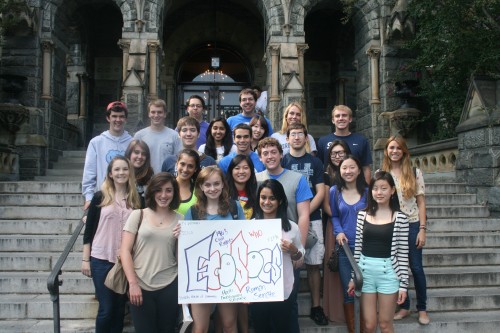The Economic and Social Council (ECOSOC) organ is led this year by the USG Chelsea Dias and dUSG Shom Mazumder. Chelsea is a junior in the college and has previously served on the secretariat for NCSC (Georgetown’s collegiate conference) and competed at NAIMUN all four years of high school. Shom is a sophomore in the School of Foreign Service and travels with the Georgetown Model United Nations team frequently.
This year, ECOSOCs are composed of eight committees that cover a wide variety of topics, time periods, and geographic locations. Those eight committees are the World Health Organization, the Islamic Educational Scientific Organization, the British House of Commons, United Nations Women, FIFA Steering Committee, the Roman Senate, and the 1963 Civil Rights Convention.
There are a few “fun facts” about the committees in ECOSOCs this year. First, in keeping with the theme of NAIMUN 50, the 1963 Civil Rights committee will be taking place during the same year that NAIMUN first started. This can also be seen in some other committees throughout the conference, including the United Nations Security Council 1963 and the Political and Security Committee 1963. Another interesting fact is that the Haiti Earthquake response committee was designed as an innovative approach to the traditional NGO Forum that has been found at NAIMUN in the past. The committee will hopefully provide delegates with a more structured debate as they represent various non-governmental entities.
There is much behind-the-scenes preparation work that goes on in the weeks leading up to NAIMUN. There are the obvious bits of preparation – such as the execution, editing, and formatting of the background guides. But then there are also other parts of the planning process that can easily be overlooked but which are very important for the committee experience. These parts of the planning process include holding meetings with individual committees, training chairs and directors, coordinating what materials will be needed in committee, and creating committee videos that enable the MUN simulation to come to life.
An interesting aspect of Model UN conferences that delegates often do not get to see is the selection of committees. As can be seen from the list of committees on the NAIMUN 50 website, the committees are diverse and unique. The way that NAIMUN structures committee selection involves an application process. When applying, Chairs and Crisis Managers can select committees from a list of options provided by the Undersecretaries General or alternatively propose their own committee ideas. Various factors, including feasibility, size constraints, and realism need to be taken into account during the ultimate selection. Additionally, the committees must be evaluated in order to ensure that there is not too much of a focus on one geographic area or one substantive topic. This entire process takes about three weeks, but ultimately results in engaging and exciting committees for the delegates.
Planning a conference as extensive as NAIMUN 50 has been a very rewarding experience – especially having the opportunity to work with other individuals who are so committed and dedicated. But most importantly, this weekend is about the delegates. Model UN has been one of the defining experiences in both of our lives here at Georgetown. It is our utmost pleasure to pass on our passion for fierce debate, for engaging negotiations, and most importantly, for fun onto all of the delegates attending NAIMUN 50! We cannot wait to see the product of our hard work in a few short weeks!
Chelsea Dias
USG of Economic and Social Council NAIMUN 50
Shom Mazumder
USG of Economic and Social Council NAIMUN 50



